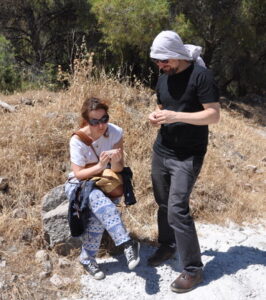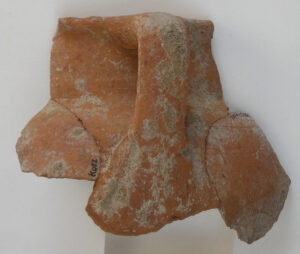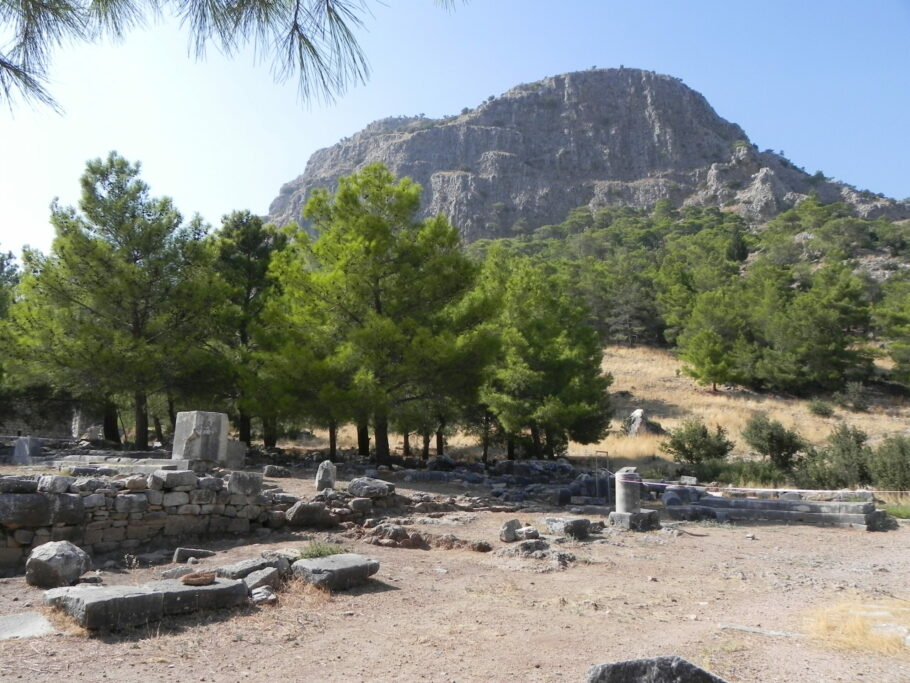Four centuries of cooking wares at Priene (Western Turkey)
A newly published paper on a diachronic and multidisciplinary study of cooking pottery from the famous site of Priene, western Turkey, reveals that manufacturing technologies and the origins of imports trace important historical developments in this region during the Classical, Hellenistic and early Roman periods. This is significant research for many reasons, not least because it deals with an understudied class of ceramic objects, but also because it demonstrates the huge potential of diachronic studies of this kind and the importance of combining scientific methods with historical and archaeological records.
Here at the Fitch, we first met Silvia Amicone and Lars Heinze when they attended the Fitch Ceramic Petrology course (in 2012 and 2017 respectively) and then formed a closer collaboration when Silvia was awarded a Fitch Bursary for this project in 2015/16. The Fitch team are very proud to have been a part of this study and thank Silvia and Lars for bringing this opportunity to us. Below, Silvia shares the story behind the project and the development of it:
This project was conceived at the 2011 Keramos Symposium, organised by Ege University of Izmir, where Lars and I first met. Here we chatted about our interests and began discussing a potential interdisciplinary, collaborative project on ceramics from Priene. This first chat led directly to my brief visit in Priene in 2012, were we looked at material contexts under investigation by various researchers working on the excavation. It did not take us long to see the enormous potential that the cooking wares had for an integrated archaeometric study, and this is where the project was truly conceptualised.

For the few who are not acquainted with Priene, this (mostly) Greek city located in the historical region of Asia Minor (modern Turkey) is renowned for displaying an organised rectangular layout of a planned city, nestled in the dramatic landscape of the Mykale Mountains. The well-preserved public and private buildings were mostly unearthed during extensive excavations in the late 19th century and led to the emphatic declaration of one the excavators that the “Pompeii of Asia Minor” has been discovered.
As the polis steadily lost importance in Imperial Roman times and larger building activities came to a halt, the city was frozen in time and now is a textbook case for a well-preserved Hellenistic mid-sized town. With a rich and well published corpus of inscriptions and the famous temple of Athena Polias, featured in the De Architectura of Vitruvius, and one of the finest examples of Ionic temple architecture, Priene is of importance for our understanding of urbanistic, political and socioeconomic developments within western Asia Minor.
The more recent archaeological investigations of a German (University of Frankfurt and University of Bonn) and now a Turkish-German team (University of Bursa and University of Frankfurt) at Priene have also unearthed an exceptional stratigraphic sequence of deposits spanning from the late Classical to the early Imperial Roman period, with a huge amount of pottery that is currently in the process of being published as a series of monographs and articles.
It is well known that pottery was widely circulated in the Classical and Hellenistic world and that its study has the potential to disclose broad aspects of ancient societies, including trade networks and other economic developments. However, in most cases archaeological research into pottery trade has focused either on fine wares or on transport amphorae used to ship various commodities across the Mediterranean. Cooking pots, on the other hand, are often neglected due to the implicit assumption they are mostly locally made. However, it has become increasingly apparent that cooking wares played a comparable role as a trade commodity in their own right.
From the very beginning, our project aimed to include pottery from the earliest phase of the city (the 4th and 3rd centuries BCE), that was already studied by Lars, and to investigate in a diachronic perspective the consecutive centuries studied by other members of the Priene team. For the 2nd century BCE this would include the material from a destruction layer in the western quarters of the city (Svenja Neumann) as well as two closed contexts covering the 1st century BCE and the 1st century CE (Nina Fenn). This would allow for an evaluation of cooking wares at Priene from the time of its foundation all the way to the beginning of the decline of the city in in the early Imperial Roman period.

First preliminary results of the analysis carried out at the Institute of Archaeology of the University College London were soon presented at the Keramos Symposion in Izmir in 2015 as well as in a preliminary article in the online journal FeRA. However, the complete integration of the data would require a more intensive study of many more specimens as well as the geology around Priene. Equally, we needed to continue working on the complex petrography. Luckily, this was made possible with a three-month Fitch Laboratory Bursary at the British School at Athens (BSA). This enabled us also to integrate our existing dataset with additional elemental analysis, which – together with the measurements already done by Gerwulf Schneider on the material from Nina Fenn and Svenja Neumann – would then be combined and interpreted under the expert guidance of Evangelia Kiriatzi, and Noémi Müller, who both have considerable experience in the study of ancient ceramic and cooking pots in the Mediterranean region.
At the BSA I also had the chance to take advantage of the superb library of the school and of the Fitch Laboratory’s unique ceramic thin section reference collection. Moreover, many of the people that I met at the BSA during this stay were instrumental in this research and a source of inspiration. Among them I would like to mention Ruth Siddal and Edyta Marzec, who gave me useful advice during the petrographic analysis of this very challenging assemblage and encouraged me to publish this research.
The output of our work is now finally published as an open access article in the Journal Advances in Archaeomaterials (Elsevier). The publication contextualises the results of our analyses within the major historical changes happening in Asia Minor in the transition between Hellenistic and Roman times. In addition to tracing transformations in local and regional manufacture, our results show that cooking wares were imported to the city from several places and, moreover, at a scale at least equivalent to that typical for other categories of ceramic vessels, such as table wares.
Our work highlights the importance of studying cooking wares to explore a variety of topics such as trade, consumption, and organization of production, and what one can be achieved through a true integration of scientific analysis and archaeology.
I hope I made you curious enough about our work! If you want to know more, you can find the paper here.
